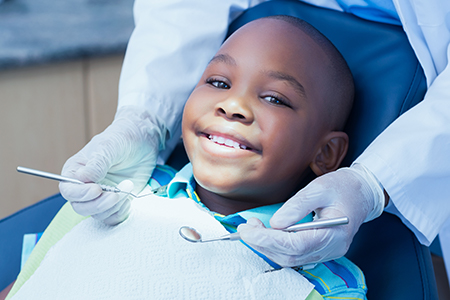
Our Office
Visit Us Online

At the office of Towne Dental & Orthodontics, we focus on more than clean teeth — we focus on building healthy habits and confident smiles that last a lifetime. Our pediatric program is designed to guide families through each stage of dental development with clear, age-appropriate care and an emphasis on prevention, comfort, and education.

Early dental experiences shape how children view their oral health for years to come. We encourage parents to establish a dental partnership early — around the first birthday or when the first tooth appears — so children become comfortable with dental visits and parents learn the best ways to protect emerging teeth. A calm, predictable visit can turn a nervous first appointment into a positive foundation for lifelong care.
Our team creates a child-centered environment where explanations are simple, procedures are gentle, and praise is used to reinforce good habits. We use behavior guidance techniques tailored to each child’s temperament, helping them feel safe and understood. When children leave feeling respected and informed, parents often notice better cooperation at home for brushing and flossing.
Prevention is our priority. By catching small issues early and teaching families how to reduce risk, we minimize the need for invasive treatments later on. Preventive visits also allow us to monitor growth milestones and offer timely recommendations that support both dental health and overall well-being.

Good daily habits are the foundation of a healthy smile. We provide clear, practical guidance to parents and children on toothbrushing technique, age-appropriate fluoride use, and how much toothpaste is appropriate at each stage. Small changes—like swapping sugary drinks for water and offering healthier snack choices—have a measurable impact on decay risk and overall health.
Professional care complements what families do at home. Routine checkups let our clinicians remove plaque buildup, evaluate gum health, and screen for early decay. We recommend periodic cleanings and exams tailored to each child’s needs so emerging problems are identified and addressed before they escalate.
Education is part of every visit. We use simple demonstrations, visual aids, and hands-on coaching so children understand why brushing matters and parents leave with clear next steps. Helping kids take ownership of their care builds confidence and sets them up for success as they grow.
Dental visits are more than cavity checks. During each exam, we assess tooth eruption patterns, jaw alignment, and oral function. We also look for habits—from thumb-sucking to prolonged pacifier use—that can affect the bite or speech. Identifying these concerns early allows for timely guidance or referral, and often avoids more complex treatment later.
When necessary, digital radiographs give us a safe, detailed view of teeth below the surface. These images help detect hidden decay, monitor developing permanent teeth, and evaluate jaw growth without exposing children to unnecessary radiation. We only take films when clinically appropriate and always explain the reason and benefits to parents.
Tooth decay is common, but largely preventable. We focus on evidence-based strategies—fluoride, sealants, and targeted hygiene instruction—that protect vulnerable tooth surfaces. Fluoride strengthens enamel and makes teeth more resistant to acid attack, while sealants provide a physical barrier on chewing surfaces where food often lodges.
Sealants are applied painlessly and can be especially helpful after permanent molars erupt. They are thin, protective coatings placed in the grooves of back teeth to reduce the risk of decay. For many children, sealants paired with routine care significantly lower cavity rates and preserve healthy tooth structure.
Behavioral strategies also matter: consistent brushing with fluoride toothpaste, limiting frequent snacking of sugary foods, and avoiding bottles or sippy cups filled with juice or milk during sleep all reduce decay risk. We work collaboratively with families to develop realistic plans that fit daily life.
Establish a dental home early and keep regular preventive visits.
Use an age-appropriate toothbrush and a smear or pea-sized amount of fluoride toothpaste as recommended.
Limit sugary drinks and encourage water; avoid letting young children fall asleep with bottles of milk or juice.
Help children transition away from pacifiers and thumb-sucking at the recommended age to protect dental development.
Consider professionally applied sealants for newly erupted permanent molars and follow up with scheduled cleanings.
Make protective mouthguards a habit for contact sports to reduce the risk of dental trauma.

Baby teeth serve important roles: they help with eating, speech development, and maintaining space for permanent teeth. Because baby teeth influence long-term alignment, we treat their care seriously. Parents often wonder about teething discomfort and safe ways to soothe their children; simple, evidence-based measures can ease symptoms without medication in most cases.
For cleaning early teeth, a soft infant toothbrush or a damp washcloth is usually sufficient at first. As more teeth come in, we introduce brushing with a tiny smear of fluoride toothpaste and gradually transition responsibility to the child under parental supervision. When used consistently, these routines protect baby teeth and establish life-long habits.
We also monitor conditions like early childhood caries (sometimes called baby bottle decay) and offer clear guidance on how to reduce risk. Parents receive straightforward advice about feeding practices, nighttime routines, and strategies for preventing decay that respects family routines and individual needs.
Children’s mouths change rapidly. Regular dental exams allow us to track facial growth, jaw development, and tooth alignment so we can recommend early orthodontic consultation if needed. Early observation helps identify concerns such as crossbites, crowding, or harmful oral habits that may benefit from timely intervention.
Active children also face unique dental risks. For athletes, a properly fitted mouthguard is a simple, effective safeguard against chipped, broken, or displaced teeth. We can advise on the best type of protection based on the child’s sport and level of activity, helping parents weigh comfort and safety.
Nutrition remains a central theme as kids grow. A balanced diet supports tooth and bone development, while limiting frequent exposure to sugary or sticky foods reduces decay risk. We provide practical, age-appropriate nutrition tips that fit into busy family life and help maintain strong teeth and healthy growth.
We monitor bite relationships and jaw development at routine visits. If early signs suggest a developing orthodontic issue, we discuss options and timing so families can make informed choices. Often, observation and minor guidance are sufficient; in other cases, a referral for early orthodontic assessment can simplify future care.
Encouraging a diet rich in whole foods—fruits, vegetables, lean proteins, and dairy—provides nutrients essential for oral and overall health. Reducing frequent snacking on sugar-laden foods and beverages lowers the risk of decay and supports steady energy for learning and play.
Summary: Good pediatric dental care blends prevention, education, and compassionate clinical treatment. From a child’s first tooth through the teenage years, consistent dental visits, smart daily habits, and early attention to growth and alignment help preserve healthy, confident smiles. If you would like to learn more or discuss your child’s dental needs, please contact us for additional information.
A pedodontist is a dentist who has received advanced specialty training in meeting the dental needs of children from infancy to adolescence. Pedodontists, also referred to as "pediatric dentists," study child psychology, behavior management, caring for children with special needs, methods of handling oral/facial trauma, and various techniques for providing anesthesia and sedation. Pedodontists also understand the complexities of facial growth and development and have the clinical skills required to meet the dental needs of all children at every stage of development. Most of all, pedodontists are passionate about what they do and enjoy working with children. They strive to make every dental experience a positive one as they help children establish a strong foundation for good oral health.
Even before your child is born, their first set of teeth is already forming. In fact, by one year of age, some of your baby's front teeth will have already come into place. While the arrival of your baby's first teeth is only one of many developmental milestones, it represents an excellent time to begin a program of oral care. According to recommendations from the American Dental Association, babies should see the dentist around the time of their first birthdays.
Your baby's first teeth typically begin to appear in the 6 to 12-month range. While this is an extraordinary milestone, you need to be aware that your baby may find the experience a little bit uncomfortable. Teething can make babies feel irritable. They may be fussy, have trouble sleeping, not want to eat, and drool quite a bit.
Although you are powerless to speed up the process of teething, there are a few things that you can do to soothe your baby as the new teeth are erupting into place. Common approaches to helping your baby feel more comfortable while getting new teeth, include teething rings or a cold spoon or moist gauze rubbed over their gums.
Even for these few new teeth, it's absolutely essential to establish an effective regimen of oral care. For information on when your baby's first set of teeth will erupt into place, consult this timeline from the American Dental Association: Eruption Charts
Some children persist in sucking their thumbs or fingers beyond their preschool years. For these children, the activity continues to be a source of comfort, relaxation, and security. It may even help them fall asleep at night. However, it's essential to be aware that in the long-term, a finger sucking habit is not healthy.
If your child's thumb or finger sucking habit is still present when the permanent teeth begin to come in, your child is at a higher risk of developing a bad bite. By the age of five or six years, you need to constructively and gently help your child stop the habit.
It's also a good idea to have a comprehensive evaluation at this time. Your pedodontist can assess if there are any habit related alterations to the alignment of your child's teeth or jaws, or if it is affecting their speech or swallowing patterns. They can also discuss habit control strategies with you, as well as follow your child's bite and facial development as they grow. If interceptive appliances or corrective orthodontic care are recommended, the timetable and best options in care will be explained in complete detail.
At Towne Dental & Orthodontics we recommend a child's first dental visit by their first birthday or within six months of the first tooth erupting. Early visits let clinicians check development, remove plaque buildup, and teach parents safe home care. Starting early helps children become familiar with the dental office and reduces anxiety about future visits.
An initial appointment focuses on a gentle exam, simple cleaning if appropriate, and clear guidance on feeding, fluoride, and brushing techniques. We explain what to expect at each stage of growth so parents can make informed choices as new teeth appear. Regular preventive visits after the first exam create a dental home that supports long-term oral health.
A typical pediatric visit begins with a conversation with the parent about medical history, diet, and home oral care. Then the clinician performs a focused exam of the teeth, gums, bite, and oral tissues, and checks eruption patterns and jaw development. When appropriate, the visit includes a thorough cleaning, polishing, and removal of plaque to lower decay risk.
Education is a key part of each appointment: technicians demonstrate brushing and flossing, review fluoride recommendations, and answer parental questions. If we identify early signs of decay or developmental concerns, we discuss noninvasive options and a monitoring plan. We tailor the visit to the child’s age and temperament so the experience stays positive and productive.
We use child-centered behavior guidance techniques—such as tell–show–do, distraction, and positive reinforcement—to help children feel safe and in control. Explanations are kept simple and honest, and we allow time for acclimation so that procedures feel predictable rather than frightening. Our team is trained to recognize fear cues and adjust the approach to each child’s emotional needs.
For children who need additional support, nitrous oxide or other minimally invasive options can be considered to ease anxiety and allow care to proceed safely. These methods are used selectively and always explained to parents before treatment begins. Our goal is to build trust so most children require progressively less support over time.
Preventive treatments for children typically include regular cleanings, fluoride applications, and dental sealants on newly erupted molars. Topical fluoride strengthens enamel and helps teeth resist decay, while sealants create a barrier on chewing surfaces where cavities often start. Routine professional care combined with effective home hygiene reduces the need for restorative procedures.
We recommend a personalized prevention schedule based on the child’s risk factors, medical history, and habits such as snacking frequency. During visits we provide hands-on coaching for parents and children so daily brushing and flossing are effective. Preventive care also includes advice on pacifier use, sippy cups, and other behaviors that influence decay risk.
Modern pediatric practices use digital radiography, which requires far less radiation than traditional film and provides detailed images for diagnosis. X‑rays are taken only when clinically necessary to evaluate hidden decay, tooth development, or injury. When images are recommended, clinicians follow strict safety protocols to minimize exposure and protect growing tissues.
The benefits of targeted imaging—such as detecting decay between teeth or monitoring unerupted permanent teeth—usually outweigh the minimal risk when films are used appropriately. We always explain the diagnostic need and expected findings so parents understand why an image is suggested. If a parent has concerns about radiation exposure, the dental team will review alternatives and timing for imaging.
To prevent early childhood caries, avoid leaving bottles or sippy cups filled with milk, formula, or juice at bedtime and offer water instead. Wiping a baby’s gums with a clean cloth after feedings and establishing toothbrushing as soon as the first tooth appears helps remove bacteria and sugar residue. Limiting frequent, sugary snacks and encouraging healthy alternatives reduces decay risk significantly.
For teething comfort, chilled teething rings, gentle gum massage, or a clean, cool washcloth are safe first-line measures. Medication or topical anesthetics should only be used under a clinician’s direction, and parents should discuss options during a visit if symptoms are severe. If a baby develops a fever, persistent irritation, or signs of infection, contact the dental office or pediatrician for evaluation.
Watch for signs such as late or early tooth eruption, asymmetric spacing, persistent thumb-sucking beyond age 4, or a crossbite that affects chewing or speech. A routine dental exam allows clinicians to track facial growth and bite relationships and identify issues that may benefit from early intervention. The American Association of Orthodontists recommends an orthodontic evaluation by about age 7 when certain developmental concerns can be spotted.
Early monitoring does not always mean early treatment, but timely referral can simplify future care and reduce the need for complex procedures later. If we observe crowding, bite discrepancies, or jaw asymmetry, we will discuss options and the right timing for any orthodontic input. Working with parents and specialists, our goal is to support healthy development with the least invasive approach possible.
In dental emergencies such as a knocked‑out tooth, uncontrolled bleeding, or a severe toothache with swelling, seek prompt care to protect the tooth and overall health. For an avulsed permanent tooth, hold it by the crown, rinse gently if dirty, and store it in milk or saline while you seek immediate dental attention. If a baby tooth is knocked out, avoid replanting it and still contact your dentist to assess the injury and rule out damage to developing teeth.
For severe pain, swelling, or signs of infection—such as fever and spreading redness—contact your dental provider or pediatrician right away for evaluation and treatment. If you need guidance after hours, the office of Towne Dental & Orthodontics can advise on next steps and available emergency resources in the Waller area. Quick action often preserves options for saving injured teeth and reduces the risk of complications.
A balanced diet rich in whole foods, dairy, lean proteins, fruits, and vegetables provides nutrients essential for tooth and jaw development. Limiting frequent consumption of sugary or sticky snacks and choosing water instead of sweetened beverages lowers the chance of decay. Encouraging regular meal times rather than constant grazing reduces acid attacks on enamel throughout the day.
Daily habits like brushing twice with fluoride toothpaste, flossing as appropriate, and supervising young children’s oral care build a strong foundation for oral health. Parents should also plan regular dental visits so clinicians can reinforce good habits and catch problems early. Pairing sound nutrition with preventive care supports healthy growth and fewer dental problems as children mature.
Mouthguards are a simple and effective way to reduce the risk of chipped, broken, or displaced teeth during contact and collision sports. We recommend that children who play organized or recreational sports wear a properly fitted mouthguard every time they participate. Boil‑and‑bite guards offer basic protection, but a custom mouthguard fitted by a dental professional provides the best comfort and coverage.
Custom mouthguards are made to match a child’s dental anatomy and are more likely to be worn consistently because they fit better and are easier to speak and breathe in. If a child needs a mouthguard, the dental team can discuss the best option based on the sport, the child’s age, and any orthodontic appliances. Proper care, including rinsing after use and storing in a ventilated case, helps the guard last longer and remain hygienic. Regular checks ensure the guard still fits as teeth change and orthodontic treatments progress.